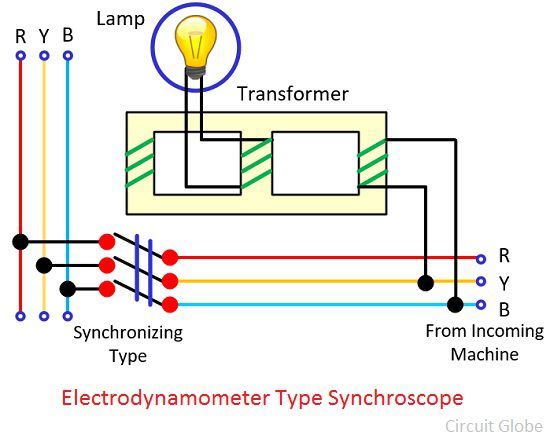Definition: The synchroscope is a device which shows the correct instant at which the two systems are synchronised. The terms ‘synchronize’ means the machines of equal frequency and voltage are operating parallel to each other.
The synchroscope consists the two-phase wound stator and rotor. The alternators provide the two-phase supply to the synchroscope. If any of the two phases of the machine are synchronised, then the third phase was automatically being synchronized.
The existing alternator gives the supply to the stator of the synchroscope. And the incoming alternator gives the supply to the rotor. The phase shift between the supplies indicates the difference in phase and frequency to the alternators connected parallel to each other. The synchroscope also indicates the speed (i.e., running fast or slow) of the incoming alternator.
The synchroscope starts operating when the alternators of different frequencies are connected to each other. If the frequency of rotor and stator remain same then the rotor will not rotate or becomes stationary, i.e., the dial also remains stationary. When the frequency of rotor and stator supply changes then the rotor starts rotating. i.e., the dials also start deflecting.
The speed of the rotor depends on the difference of the supply frequency. If the differences are large, then the rotor will rotate at high speed and if the differences are less than the speed of the rotor will become less.
Types of Synchroscope
Electrodynamometer Type Synchroscope
The static and dynamic are the two main parts of the electrodynamometer synchroscope. The static part of the synchroscope consists the three-limbed transformer and the lamp. The bus-bar excites one of the windings of the transformer, and the other two windings are excited by the incoming machines. The lamp is connected to the central limb of the transformer.
The winding of the outer limb of the transformer induces two flux. And the flux of the central limb is the resultant of the outer two limb flux. The resultant flux induces the EMF in the central winding of the transformer. The outer limbs of the transformer are connected in such a way so that if the incoming machines are in phase with each other than maximum EMF induces in the central limb winding of the transformer. And hence the lamp glows brightly.
If the voltages of the incoming machines are out of phase to each other in that case the resultant flux of the central limb of the transformer becomes zero, and hence the lamp will not glow. If the frequencies of the incoming machines and bus bar are not similar to each other in that case, the lamp becomes flicker.
The frequency of flickering is similar to the difference in frequencies of the two. The synchronisation can be done when the brightness is maximum and flickering becomes less. The electrostatic instrument is used in the system for determining the speed of the incoming machines.
Moving Iron Synchroscope
The moving iron instrument has two fixed parts. The fixed part A is designed for the small value of current, and the resistance is connected in series with the part. The synchroscope consists two cylinders which are mounted on the spindle. The pressure coil energises these cylinders.
The pressure coil is linked with two phases of the incoming machine. The resistance is connected in series with one of the pressure coil and the inductance with another of the coil. The resistance and inductance of the pressure coil create the phase difference of 90º between the pressure coils.
When the frequency of the incoming machines and the bus-bar are matched, then the spindle rotates. The revolution per second determines the differences between the frequencies of the two.



Very interesting article. I am also a blogger. I read your articles regularity and like very much. Thanks for sharing such an informative article.
Why synchroscope pointer moves clockwise and anticlockwise ?